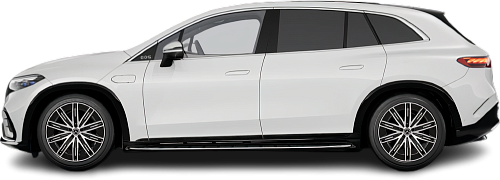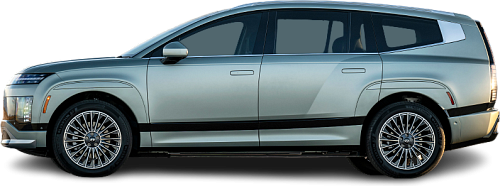Global EV Comparison: Mercedes EQS SUV 500 4MATIC vs Hyundai Ioniq 9 Performance AWD
Struggling to Decide? Let AI Help!
Your AI Summary Is Ready!
General Info
The Hyundai Ioniq 9 Performance AWD (2025-…) is currently produced, it has a starting price of €79000. The Mercedes EQS SUV 500 4MATIC (2022-2023) has been discontinued. You can find it for as low as €97770 on the used car market.
The two vehicles share the same body style: SUV.
| Property | Mercedes EQS SUV 500 4MATIC | Hyundai Ioniq 9 Performance AWD |
|---|---|---|
| Years of Production | 2022-2023 | 2025-… |
| Current Status | Discontinued | Produced |
| Country of Manufacture | USA | South Korea, USA |
| Body Style | SUV | SUV |
| Market Availability | EU | EU, USA |
| Price Europe (New) | - Price Europe (New) | €79000 |
| Price Europe (Used) | €97770 | - Price Europe (Used) |
| GCC Score | 7 | 7.8 |
Range and Efficiency
Even though the Mercedes EQS SUV 500 4MATIC (2022-2023) has a larger battery, the Hyundai Ioniq 9 Performance AWD (2025-…) higher energy efficiency results in a longer real-world driving range.
| Property | Mercedes EQS SUV 500 4MATIC | Hyundai Ioniq 9 Performance AWD |
|---|---|---|
| Range (EPA) | - Range (EPA) | 501 km |
| Range (WLTP) | 616 km | 600 km |
| Range (GCC) | 492 km | 493 km |
| Battery Capacity (Nominal) | 120 kWh | 110.3 kWh |
| Battery Capacity (Usable) | 108.4 kWh | 106 kWh |
| Efficiency per 100 km | 22 kWh/100 km | 21.5 kWh/100 km |
| Efficiency per kWh | 4.54 km/kWh | 4.65 km/kWh |
| Range and Efficiency Score | 6.7 | 6.9 |
Charging
The Hyundai Ioniq 9 Performance AWD (2025-…) features an advanced 800-volt architecture, whereas the Mercedes EQS SUV 500 4MATIC (2022-2023) relies on a standard 400-volt system.
The Hyundai Ioniq 9 Performance AWD (2025-…) offers faster charging speeds at DC stations, reaching up to 350 kW, while the Mercedes EQS SUV 500 4MATIC (2022-2023) maxes out at 207 kW.
Both vehicles are equipped with the same on-board charger, supporting a maximum AC charging power of 11 kW.
| Property | Mercedes EQS SUV 500 4MATIC | Hyundai Ioniq 9 Performance AWD |
|---|---|---|
| Max Charging Power (AC) | 11 kW | 11 kW |
| Max Charging Power (DC) | 207 kW | 350 kW |
| Architecture | 400 V | 800 V |
| Charge Port | CCS Type 2 | CCS Type 2 |
| Charging Score | 7.1 | 8.6 |
Performance
Both vehicles are all-wheel drive.
Both cars deliver the same 0-100 km/h acceleration time, but the Mercedes EQS SUV 500 4MATIC (2022-2023) boasts greater motor power.
| Property | Mercedes EQS SUV 500 4MATIC | Hyundai Ioniq 9 Performance AWD |
|---|---|---|
| Drive Type | AWD | AWD |
| Motor Type | PMSM (front), PMSM (rear) | PMSM (front), PMSM (rear) |
| Motor Power (kW) | 330 kW | 315 kW |
| Motor Power (hp) | 443 hp | 422 hp |
| Motor Torque | 828 Nm | 700 Nm |
| 0-100 km/h | 5.2 s | 5.2 s |
| Top Speed | 210 km/h | 200 km/h |
| Performance Score | 6.2 | 5.8 |
Dimensions
The Hyundai Ioniq 9 Performance AWD (2025-…) is taller, but has a similar length and width to the Mercedes EQS SUV 500 4MATIC (2022-2023).
The Mercedes EQS SUV 500 4MATIC (2022-2023) boasts a more extended wheelbase.
| Property | Mercedes EQS SUV 500 4MATIC | Hyundai Ioniq 9 Performance AWD |
|---|---|---|
| Length | 5125 mm | 5060 mm |
| Width (with Mirrors) | 2157 mm | - Width (with Mirrors) |
| Width (w/o Mirrors) | 1959 mm | 1980 mm |
| Height | 1718 mm | 1790 mm |
| Wheelbase | 3210 mm | 3130 mm |
Cargo and Towing
The Mercedes EQS SUV 500 4MATIC (2022-2023) features a larger trunk, but the Hyundai Ioniq 9 Performance AWD (2025-…) offers greater maximum cargo capacity when the rear seats are folded.
A frunk (front trunk) is available in the Hyundai Ioniq 9 Performance AWD (2025-…), but the Mercedes EQS SUV 500 4MATIC (2022-2023) doesn’t have one.
The Hyundai Ioniq 9 Performance AWD (2025-…) is better suited for heavy loads, offering a greater towing capacity than the Mercedes EQS SUV 500 4MATIC (2022-2023).
| Property | Mercedes EQS SUV 500 4MATIC | Hyundai Ioniq 9 Performance AWD |
|---|---|---|
| Number of Seats | 5, 7 | 7 |
| Curb Weight | 2805 kg | 2744 kg |
| Cargo Volume (Trunk) | 645 l | 338 l |
| Cargo Volume (Max) | 2100 l | 2435 l |
| Cargo Volume (Frunk) | - Cargo Volume (Frunk) | 52 l |
| Towing Capacity | 1800 kg | 2500 kg |
| Cargo and Towing Score | 8.4 | 9.1 |




